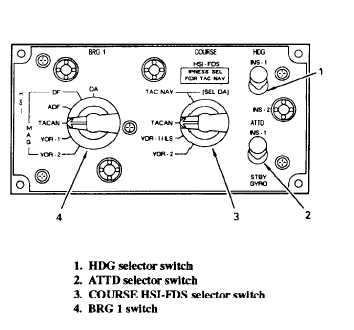TACAN signals.
When localizer signals are being
used, the deviation is relative to the localizer.
8. The To-From arrows indicate whether the
selected course is going toward or away from the
selected beacon station.
9. The course deviation dots indicate course
deviation in degrees relative to the course deviation
bar position.
10. The COURSE SET knob allows the operator
to set both the course arrow to a desired course and
the COURSE indicator to the desired course readout
when in any mode other than TAC NAV.
11. The bearing pointer 2 indicates the bearing to
a selected navigational point.
12. The HEADING SET knob allows the
operator to set the heading mark to any desired
heading.
13. The compass card indicates the aircraft
compass heading when read against the lubber line.
14. The OFF flag will appear whenever there is a
power failure.
15. The MILES counter displays a digital
readout of distance, in nautical miles, to a selected
TACAN station.
16. The aircraft symbol indicates the lubber line,
which, in turn, indicates aircraft heading.
17. The NAV flag will appear if the signal input
from the selected TACAN or VOR becomes
unreliable.
A280 PILOT HSI CONTROL.— The A280
(fig. 5-2) controls the inputs to the pilot’s HSI. This
unit allows the pilot to select inputs from the different
navigational aids. Refer to figure 5-2 when reading
the following text.
1. The HDG selector switch selects the heading
signal source for display on the HSI compass card.
The pilot can select either inertial navigation system 1
(INS-1) or inertial navigation system 2 (INS-2).
2. The ATTD selector switch selects the source
of pitch and roll signals for the flight directory
indicator (FDI) sphere. The signals will either come
from the INS-1 or from the vertical gyro (STBY
GYRO).
3. The COURSE HSI-FDS selector switch
selects the source of course signals for display on the
HSI. The signals include the course deviation and
To-From signals to position the course deviation bar
and the To-From arrows. They will come from the
VOR-2 NAV converter (VOR-2), the VOR-1 NAV
converter (VOR-1/ILS), the TACAN R/T (TACAN),
and the central computer TAC NAV) when the BRG
1 switch is in the DA position.
4. The BRG 1 switch selects the source of the
bearing signal to be displayed on the pilot’s, copilot’s,
and NAV/COMM’s HSIs bearing pointer 1. This
switch controls all three HSIs. The bearing sources
available are the VOR-2 NAV converter (VOR 2),
VOR-1 NAV converter (VOR 1), TACAN R/T
(TACAN), ADF receiver (ADF), or UHF direction
finder group (DF). In the DA position, the drift angle
supplied by the Doppler radar or the central computer
is sent to the bearing pointer 1.
A279 COPILOT HSI CONTROL.— The A279
control box (fig. 5-3) controls the inputs to the
copilot’s HSI. It allows the copilot to select the
navigational aid. Refer to figure 5-3 when reading the
following text.
1. The HDG selector switch selects the source of
heading information supplied to the HSI compass
card. Either INS-2 or INS-1 is available.
2. The ATTD selector switch selects the source
of pitch and roll signals for display on the FDI sphere.
The source can be either the INS-2 or the vertical gyro
(STBY GYRO).
Figure 5-2.-A280 pilot HSI control.
5-2

